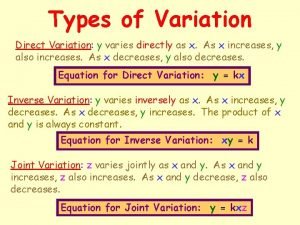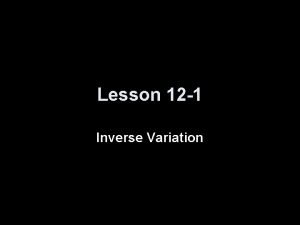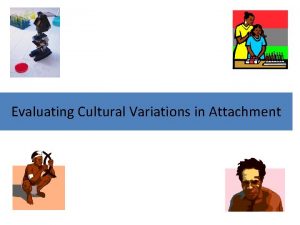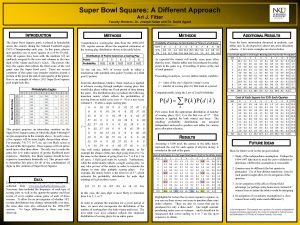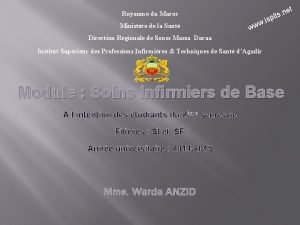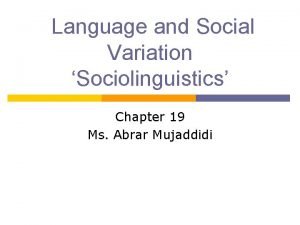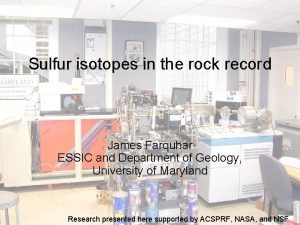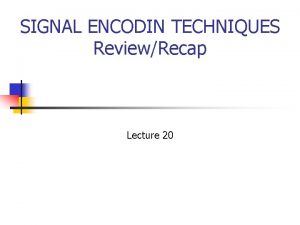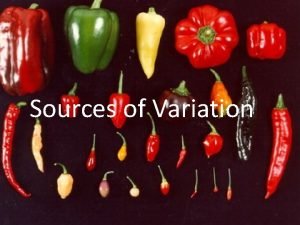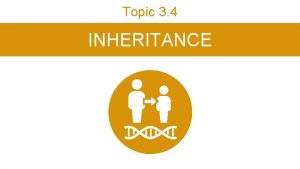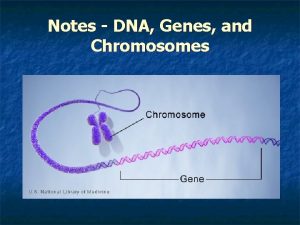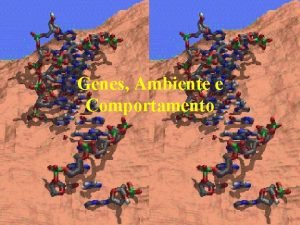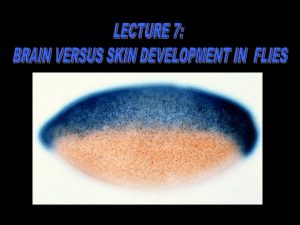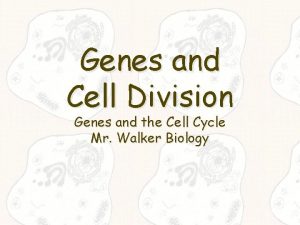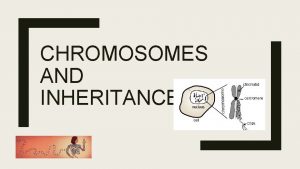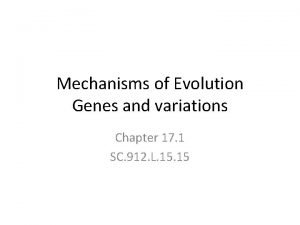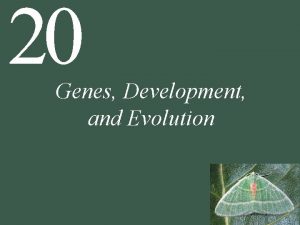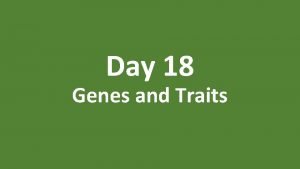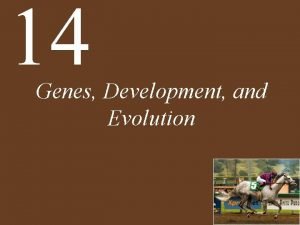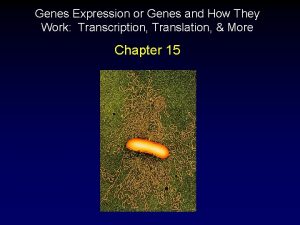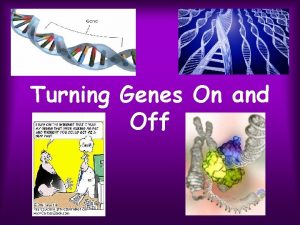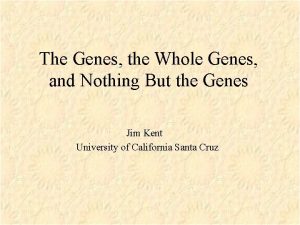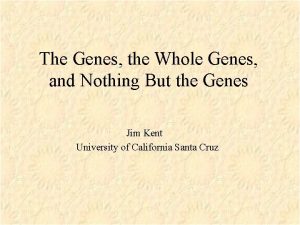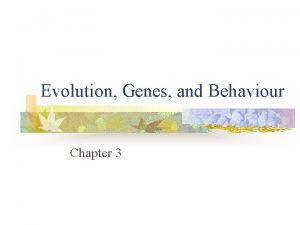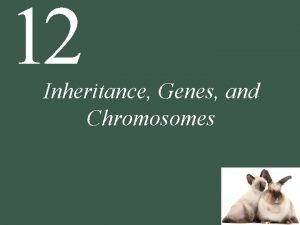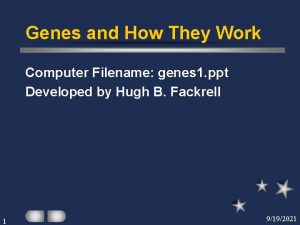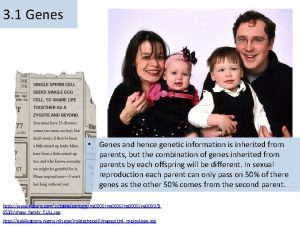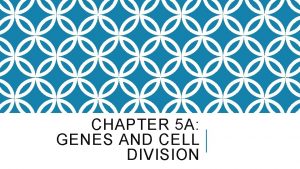Genes and Variations How do we get variations









































- Slides: 41

Genes and Variations How do we get variations in the gene pool?

Sources of Genetic Variation 1. ) Mutations: http: //www. teachersdomain. org/resource/tdc 02. sci. life. gen. mutationstory/ 2. ) Gene shuffling Due to sexual reproduction Remember: in meiosis, chromosomes/genes separate (Principle of Segregation) Crossing over also leads to variation. Think about a deck of cards…

Selection Natural selection can effect the distributions of phenotypes in 3 ways: Directional selection Stabilizing selection Disruptive selection

Directional selection Individuals at one end of a curve are more fit than other individuals. This shifts the curve in one direction.

Stabilizing Selection Occurs when individuals near the middle of the curve are more fit. The center of the curve stays in the same place, but the curve becomes narrow.

Disruptive Selection Individuals at the ends of the curve are more fit than those in the middle. Creates a “double bumped” curve.

Genetic Drift Natural selection is not the only source of evolutionary change. In large populations, probability can be used to predict genetic outcomes. In small populations, the laws of probability do not always work. Ex: coin flip

How Does Genetic Drift Happen? In small populations, individuals that carry an allele for a trait may leave more offspring (descendants) than those who don’t have the allele just by chance. Over time, a series of these chance happenings can cause an allele to be more common.

Two methods of Genetic Drift: Founder effect Bottleneck effect

Founder Effect * A change in the allele frequencies due to the migration of a small group of organisms to a new area.

Founder Effect

Founder Effect

Bottleneck effect Change in allele frequencies due to a catastrophic event (natural disaster, disease, habitat destruction, etc. )



Amoeba Sisters: Speciation

Speciation The evolution of a new species. Geographical isolation can lead to this.

2 Ideas on how evolution occurs: Gradualism: Evolution occurs SLOWLY over a long time. Adaptations will increase in number steadily over time. Darwin’s idea. Punctuated Equilibrium: Speciation occurs in rapid bursts followed by periods of no change.


Evidence for Evolution

Evidence for Evolution Fossil Record: Fossils were known (even in Darwin’s time) to be the remains of ancient life. Also, it was known that different rock layers formed at different times in Earth’s history. Fossils that are in the different layers are of different ages; the ones in deeper layers existed before the ones in more shallow layers.

Evidence for Evolution Geographic distribution of living species Darwin’s travels Different animals on different continents descended from different ancestors. However, because animals on each continent were living in similar ecosystems and exposed to similar challenges and pressures, they developed similar body structures.


How do scientists determine the age of fossils? Radioisotope dating Isotopes are atoms with different numbers of neutrons: Carbon 12, Carbon 13, Carbon 14 is the normal isotope used for dating fossils. By measuring the half-life of the isotope, scientists can determine the age.

Adaptive Radiation The evolution of many diversely adapted species from a common ancestor upon introduction to various new environmental opportunities and challenges is called adaptive radiation. Adaptive radiation typically occurs when a few organisms make their way to new, often distant areas or when environmental changes cause numerous extinctions, opening up ecological niches for the survivors. Fossil evidence indicates that mammals underwent a dramatic adaptive radiation after the mass extinctions of dinosaurs 65 mya.

Adaptive Radiation

Convergent Evolution v. Describes 2 unrelated species that share similar traits. These similarities are not due to common ancestry, but rather a result of similar environmental factors.

Coevolution v. Describes the evolution of one species in response to new adaptations that appear in another species of which the first shares close interaction

Evidence for Evolution Compared Embryology: Embryology is the study of embryos, the early stages of animal development. Early in development, the embryos of different animals are hard to tell apart.


Comparative Embryology v. Example: v. Gill slits are found in fish, chicken, pig, and human embryos


Anatomical Homologies v. Homologous structures are similar structures occurring in different species that are believed to be derived from a common ancestor. v. Analogous structures are similar structures occurring in different species that are believed to be the result of convergent evolution.

Evidence for Evolution Homologous body structures: Limbs of organisms, for example, have different forms and functions, but are made of the same basic bones. The same bones in our arms are in the wings of a bird.

Anatomical Homologies v. The forelimbs of all mammals, including humans, cats, whales, and bats, show the same arrangement of bones from the shoulder to the tips of the digits, even though these appendages can have very different functions – lifting, walking, swimming, and flying.


Anatomical Homologies v Vestigial Organs v A vestigial organ is a structure of marginal, if any, importance to an organism. Vestigial organs are historical remnants of structures that had important functions in ancestors.

Fossil Evidence v Evidence suggests that whales evolved from terrestrial ancestors v Paleontologists in Egypt and Pakistan have identified that extinct whales had hind limbs v This is a fossil of a Basilosaurus Whale, which is extinct

Genetics & DNA Similarities v. Systematists compare long stretches of DNA and even entire genomes to assess relationships between species. v. If genes in two organisms share many portions of their nucleotide sequences, it is highly likely that the genes are homologous.


Major “Ages” in the History of the Earth:
 Get on / get off transport
Get on / get off transport Linked genes and unlinked genes
Linked genes and unlinked genes Linked genes and unlinked genes
Linked genes and unlinked genes Genepattern
Genepattern You're my kryptonite metaphor
You're my kryptonite metaphor Get up get moving quiz
Get up get moving quiz Get up get moving quiz
Get up get moving quiz Get up get moving
Get up get moving Sequence pseudocode
Sequence pseudocode Get focused get results
Get focused get results Get up get moving quiz
Get up get moving quiz Spec rating formula in computer organization
Spec rating formula in computer organization Condition for thermal stability in transistor
Condition for thermal stability in transistor Valuation of variations
Valuation of variations Types of direct variation
Types of direct variation Inverse variation graph
Inverse variation graph Kwhl chart
Kwhl chart Cultural variations in attachment
Cultural variations in attachment Super bowl squares variations
Super bowl squares variations Joint variation math
Joint variation math Variations pathologiques de la température
Variations pathologiques de la température Example of two factor theory
Example of two factor theory When to use cosine rule
When to use cosine rule Variations de stock
Variations de stock Register (sociolinguistics)
Register (sociolinguistics) Possible variations
Possible variations Possible variations
Possible variations Language variation and change
Language variation and change Possible variations
Possible variations Linked list variations
Linked list variations Is direct variation a linear function
Is direct variation a linear function Independent assortment of chromosomes
Independent assortment of chromosomes Snow white variations
Snow white variations Balancing demand and capacity
Balancing demand and capacity Variations
Variations Variations
Variations Natural variations operations management
Natural variations operations management Autosomal dominant vs autosomal recessive
Autosomal dominant vs autosomal recessive Evolution of populations section 16-1 genes and variation
Evolution of populations section 16-1 genes and variation Dna, genes and chromosomes relationship
Dna, genes and chromosomes relationship How do you know if a karyotype is male or female
How do you know if a karyotype is male or female Genetics is the study of heredity
Genetics is the study of heredity














